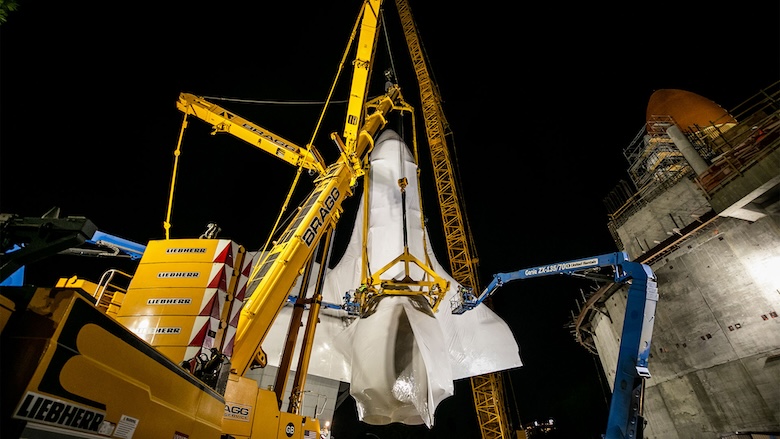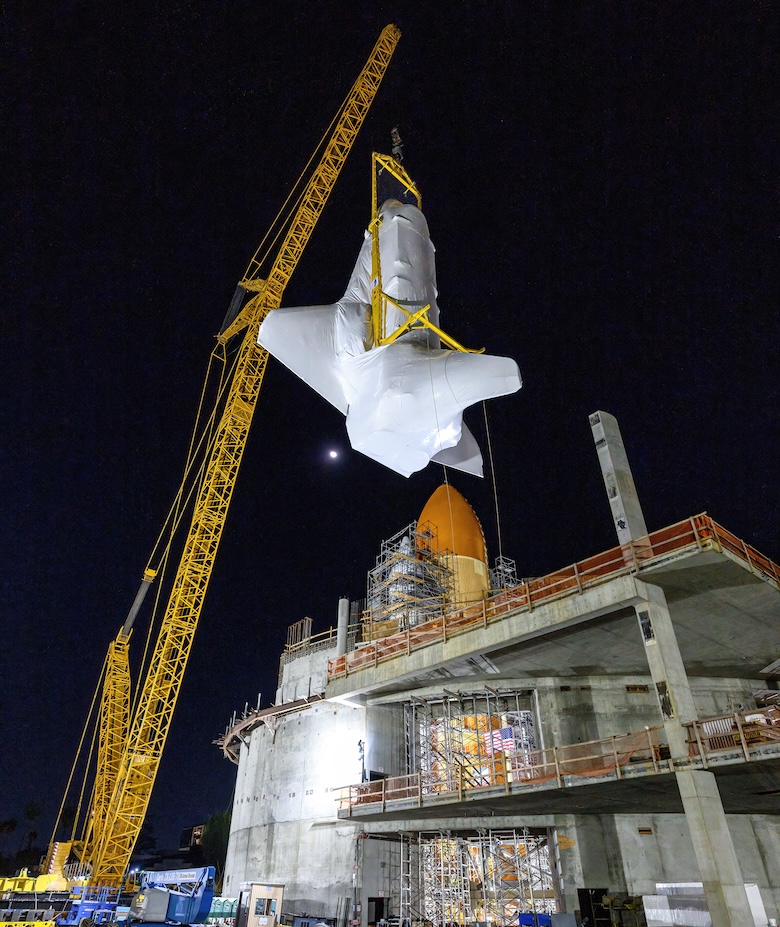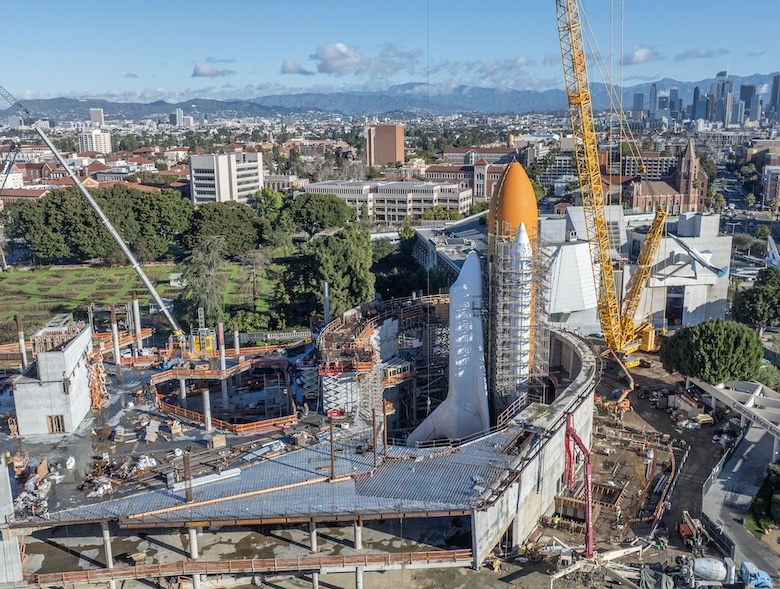An LR 1750/2 hydraulic crawler crane lifted the Endeavor space shuttle orbiter into launch position at the Samuel Oschin Air and Space Center.

Preserving humanity’s accomplishments keeps a record of our existence and our exploration of the vast unknown. The Endeavor space shuttle orbiter, which flew 25 missions from 1992 to 2011, was one such accomplishment. In 2012, the shuttle traveled to the California Science Center to spend its retirement on display for public marvel. For nearly 12 years, the 178,000-lb spacecraft lay horizontal in the Samuel Oschin Pavilion, showcasing its 122-ft long body and 78-ft wingspan. However, in January 2024, the Endeavor took a turn — upward.
The orbiter, along with two aft skirts, two solid rocket boosters, and an external tank, now stands vertically in a ready-to-launch position at the Science Center’s new Samuel Oschin Air and Space Center. This move took two years of pre-construction and lift planning as part of the “Go for Stack” process, which commenced in July 2023. After the aft skirts, boosters, and tank were installed, the last step in the six-month process was to position the shuttle. But how does one move a 178,000-lb space shuttle and place it precisely in a launch position?
Bragg Companies, a crane service in Long Beach, California, was hired for the lifting and used about five cranes for each lift. A Liebherr LR 1750/2 hydraulic crawler crane was onsite full time working concurrently with various hydraulic truck cranes throughout the project. The Liebherr LR 1750 crawler crane had 1,466,000 lb of counterweight, a tip height of approximately 395 ft, and a maximum radius of approximately 151 ft.

“The Liebherr LR 1750’s capability of electronically limiting the hoist and swing speed was vital to the success of the lifts due to the extremely tight tolerances in the pit and constant wind speed variables at the tip height,” said Justin Lambert, general manager of Bragg Crane & Rigging, in a press release.
Crawler cranes move on tracks (or crawlers) instead of wheels, which provides stability and allows the crane to operate on soft ground and rough, uneven terrain. They are often used for wind turbines, oil rigs, airports, dams, shipbuilding, and numerous other industries and applications. Though hydraulic crawler cranes are considered the heavyweights in construction projects, the wind is their nemesis. Wind can impact load and crane stability, increasing safety risks and complicating lifting and placement.
During various lifts at the Science Center, high winds and rain affected the team when picking and setting the flight components into the new building. Due to the sheer size and large surface areas, all lifting needed to occur in minimal wind conditions, which occurred during early morning hours.
To kick off the stacking process, Bragg loaded and transported the aft skirts from Mojave, California, to Los Angeles and then used a Liebherr LR 1750 crawler crane to lift and set the skirts. The company then used the crawler crane and a Liebherr LTM 1160 mobile crane to lift, upend, and set the solid rocket motors and external tank into their final positions.
The largest piece to maneuver was the Endeavour orbiter. After a difficult transport process, a Liebherr LR 1750 hydraulic crawler crane, with support from Liebherr LTM 1400 and LTM 1160 mobile cranes, lifted, upended, and set the Endeavor inside the new Samuel Oschin Air and Space Center building.
The most challenging part of the stack was attaching the external tank to Endeavour. Placing the tank was arduous as it had to be threaded down through the scaffolding without its outer foam layer contacting anything. The tight tolerances of the mating points to the solid rocket boosters added to the difficulty. After almost 14 hours, on January 31, 2024, the Endeavour was fully detached from the crane and sling, and the final mating of the space shuttle to the external tank and two solid rocket boosters was complete.
“With the lift and mating of Endeavour, we have successfully completed the last-ever space shuttle stack. This is a dream over thirty years in the making, and a feat that has never before been accomplished outside of a NASA or Air Force facility,” said Jeffrey Rudolph, president and CEO of the California Science Center, in a press release.

Along with making and preserving history, Liebherr is looking toward the future and updating its crane technologies with net-zero targets in mind. In recent years, the company has introduced multiple “unplugged” machines, including crawler cranes and drilling and piling rigs. The unplugged crawler cranes have electro-hydraulic drives with performance specifications on par with their conventional versions. Their lithium-ion battery capacities are designed for 4 hr of lifting and can be recharged within 4.5 hr. Using additional batteries can also increase performance. These unplugged versions also decrease noise levels during idling mode.
Liebherr is still producing new-and-improved versions of its hydraulic machines to make transport and lifting more economical. Earlier this year, the company announced the LTR 1150, a new 60-tonne telescopic crawler crane with a 150-tonne lifting capacity and a transport width of 3.5 m. It is the first telescopic crawler crane equipped with the Liebherr VarioBase, which determines the optimum load capacity in real time depending on the fixed track width and the variable rotation angle. Also, for the first time for its telescopic crawler cranes, Liebherr has calculated “WindSpeed Load Charts” for the new LTR 1150 so that operators can work safely and flexibly at wind speeds up to 15.6 m/sec, even with the full load capacity in many boom positions.
Liebherr
liebherr.com
Filed Under: Featured, Mobile Hydraulic Tips, Trending